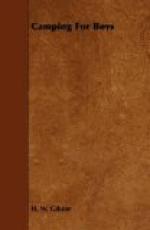What God puts in the blood is eliminated slowly and we are all impregnated with a love for the natural life which is irresistible. That was a great saying of the boy who was taken from the city for the first time on an all-night outing. Snugly tucked up in his blankets he heard the wind singing in the pines overhead. As the boy looked up, he asked, “Wasn’t God blowing His breath down at us?”—Dr. Lilburn.
Hot Stones
If the night bids fair to be cold, place a number of stones about six or eight inches in diameter next the fire, so they will get hot. These can then be placed at the feet, back, etc., as needed, and will be found good “bed warmers.” When a stone loses its heat it is replaced near the fire and a hot one is taken. If too hot, wrap the stone in a shirt or sweater or wait for it to cool off.
Night Watchers
Boys desire adventure. This desire may be gratified by the establishment of night watchers, in relays of two boys every two hours. Their imaginations will be stirred by the resistless attraction of the camp-fire and the sound of the creatures that creep at night.
Observation
Many boys have excellent eyes but see not, and good ears but hear not, all because they have not been trained to observe or to be quick to hear. A good method of teaching observation while on a hike or tramp is to have each boy jot down in a small notebook or diary of the trip the different kinds of trees, birds, animals, tracks; nature of roads, fences; peculiar rock formation, smells of plants, etc., and thus be able to tell what he saw or heard to the boys upon his return to the permanent camp or to his home.
Cameras
One of the party should take a Brownie No. 2 or small folding kodak. Photos of the trip are always a great pleasure and a memory reviver. A practical and convenient method of carrying small folding cameras is described in “Forest and Stream.” A strap with a buckle having been attached to an ordinary leather belt is run through the loops at the back of the camera-case. The camera may be pushed around the belt to the point where it will be least in the way.
Lamps
A very convenient lamp to use on a hike is the Baldwin Camp Lamp, made by John Simmons Co., 13 Franklin Street, New York City. (Price, $1.00.) It weighs only five ounces when fully charged with carbide, and is but 4-3/4 inches high. It projects a strong light 150 feet through the woods. A stiff wind will not blow it out. It can be worn comfortably in your hat or belt.
The “Rocky Mountain Searchlight,” made of a discarded tomato can, a candle, and a bit of wire for a handle, is a camp product that will be found to be very useful in an emergency.
[Illustration: Rocky Mountain Lantern]




